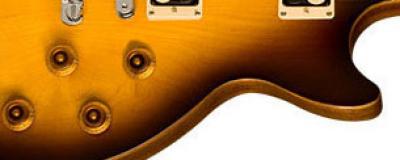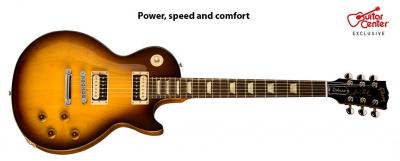I’ve been having fun fantasizing about my very own signature model Les Paul. I’ve been fussy and opinionated on a few points, and quite passive and accepting about other aspects of the design. When it comes to the electronics, though, I have a specific notion about what I’d like. First of all, let me say that I’m good with either a pair of big chrome covered PAFs, or a more hot rod looking pair with no covers, like the Les Paul Studio Deluxe ‘60s model. Either way, they’ll sound like a Les Paul to me. They need a collar around the pickups, and those collars can be plastic, any colour that complements the finish.
Controlling those pickups is another matter. It has always seemed to me that the volume and tone controls for the Les Paul are sort of in the wrong place; same thing with the pickup selector switch. I’m always bumping it when I don’t mean to.

I want the pickup selector switch placed behind the stop tailpiece. I’ve seen that on a few early B.C. Rich guitars, and I had a custom built guitar that had that configuration and it works great. That custom guitar, by the way, was a Les Paul style guitar made from walnut. It was a beauty, and unfortunately was stolen from my home. Maybe some day I’ll run across it on ebay.
One very cool feature about the Fender Stratocaster’s volume control is that the pot is situated close to the bridge and within easy distance of your little finger. It’s ideal for subtle volume swells, and not so subtle volume swells, come to that. I think my ideal Les Paul would borrow from that idea and place the bridge pickup volume near the bridge pickup and the bridge. The other front pot would be the neck pickup volume, and the remaining two controls would be their respective tone controls. One more wrinkle – I want the bridge pickup volume pot to be logarithmic instead of linear, same as a Strat.

If you aren’t cursing at your computer screen yet, let me ask for one more thing. I’d like a little discrete mini switch smack in the middle of those volume and tone pots. The switch would throw the two humbuckers out of phase with each other, so you’d only notice the effect when the pickup selector switch is in the middle (both pickups) position. Speaking of the pickup selector switch again, I don’t want the little plastic collar that says Rhythm and Treble. Please leave it off, I get which position is which without that little advisory.
I noticed that the Les Paul Studio Deluxe ‘60s described on Gibson’s site features bridge and neck pickups that can each be split via their own push/pull switch on the volume knob to achieve a single-coil tone. Sweet idea, I could go for that for sure!
OK, I’ve talked about the body, the colours choices, the finishing details, the neck, the fingerboard, tuning pegs, frets, pickups, controls, bridge and tailpiece. Stock strap buttons are fine. That’s about it for the guitar, but I’ll need a standard hardshell case, too.
How do you like my ideas for a signature model Les Paul. What to call it?
How about the Les Paul Heretic model? Or do you think my ideas are not that radical? Would you like to see a Les Paul like the one I’ve described over the last few days?








